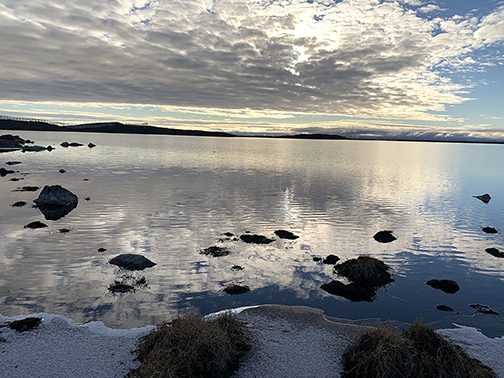From crisis to confidence: Iqaluit’s source water protection triumph
September 13, 2023

AWWA Articles
From crisis to confidence: Iqaluit’s source water protection triumph
 In the remote reaches of the Canadian Arctic lies the City of Iqaluit, a community of around 8,500 residents. At the heart of this community lies Lake Geraldine, the primary source of the city’s water supply. However, Iqaluit’s reliance on this pristine raw water source comes with unique challenges, especially during the long and harsh winter months. In October 2021, these challenges took an unexpected turn as residents began detecting a peculiar fuel-like smell in their tap water. This marked the onset of the Iqaluit Water Crisis, triggering swift and coordinated action to identify the contamination source, develop solutions, and restore the safety and sustainability of the water treatment system. (Pictured right: Lake Geraldine)
In the remote reaches of the Canadian Arctic lies the City of Iqaluit, a community of around 8,500 residents. At the heart of this community lies Lake Geraldine, the primary source of the city’s water supply. However, Iqaluit’s reliance on this pristine raw water source comes with unique challenges, especially during the long and harsh winter months. In October 2021, these challenges took an unexpected turn as residents began detecting a peculiar fuel-like smell in their tap water. This marked the onset of the Iqaluit Water Crisis, triggering swift and coordinated action to identify the contamination source, develop solutions, and restore the safety and sustainability of the water treatment system. (Pictured right: Lake Geraldine)
Facing Remote Realities
Situated approximately 1,275 miles north of Montreal, Iqaluit’s remote northern location and harsh winter climate posed significant logistical and operational challenges during the crisis. Transporting goods, equipment and laboratory results proved time-consuming and costly due to limited accessibility through air travel. “One of the greatest challenges associated with source water protection in remote communities is monitoring and controls,” notes Ian Moran, process design and optimization engineer at WSP. Overcoming the lack of a reliable network required creative strategies to relay critical information back to the Supervisory Control and Data Acquisition (SCADA) system.
Unraveling the Mystery
WSP, a global engineering firm, was enlisted to investigate the water treatment plant and find the root cause of the contamination. The team discovered a sub-surface cavity beneath the water treatment plant, which was aptly named “The Void.” Within this cavity lay a deteriorated fuel storage tank, and its contents had spilled into the space directly beneath the water treatment plant. The challenge became twofold: understanding the contamination’s origin and addressing it effectively.
Innovative Technology at Play
 “In light of the lead times between water quality sampling and receiving results, our team worked with the City to install a hydrocarbon monitoring system capable of real-time data gathering and interpretation,” Ian Moran explains. This spectrophotometer device enabled swift response by providing immediate results, aiding in the City’s critical decision-making process. Real-time monitoring systems enhanced the team’s ability to track contamination movement throughout the water supply system, a crucial factor in effectively managing the crisis. (Pictured left: Iqaluit Water Treatment Plant)
“In light of the lead times between water quality sampling and receiving results, our team worked with the City to install a hydrocarbon monitoring system capable of real-time data gathering and interpretation,” Ian Moran explains. This spectrophotometer device enabled swift response by providing immediate results, aiding in the City’s critical decision-making process. Real-time monitoring systems enhanced the team’s ability to track contamination movement throughout the water supply system, a crucial factor in effectively managing the crisis. (Pictured left: Iqaluit Water Treatment Plant)
Overcoming Logistical and Technical Hurdles
Collaboration among various stakeholders, including city officials, regulatory bodies, and Indigenous groups, was essential in tackling the crisis. The City engaged stakeholders through the Coordinated Emergency Response Committee, facilitating continuous updates, resource sharing and community-driven objectives. “Fluent teamwork across all disciplines was a major driver for success,” said Moran. Diligent documentation, internal audits and third-party reviews ensured a comprehensive and effective plan, prioritizing public safety above all.
Navigating the Second Wave
After successfully addressing the initial contamination, a similar odor resurfaced a few months later. However, armed with the spectrophotometer and a newly developed contamination response plan, the team was prepared to act decisively. The technology’s early warning capabilities facilitated the prompt activation of a new bypass system, preventing further contamination from entering the municipal water supply. Rigorous investigations identified a separate hydrocarbon event stemming from improperly installed infrastructure.
Restoring Consumer Confidence
Engaging with consumers and stakeholders played a pivotal role in rebuilding trust. The City’s transparency in sharing water quality results, backed by engineering interpretations, kept the public informed and involved. “The Iqaluit Water Crisis demonstrated the strong positive impact that having these kinds of conversations can have with consumers to get them involved and keep them informed,” emphasized Moran.
Lessons Learned and Upgrades Implemented
The crisis prompted a series of comprehensive actions. Remediation efforts included cleaning The Void, removing a decades-old underground fuel storage tank, and conducting a Phase II Environmental Site Assessment. Collaboratively, the team designed an emergency response plan, enhanced standard operating procedures and updated monitoring and reporting protocols. These measures ensured a more resilient and responsive water treatment system.
The Iqaluit Water Crisis exemplifies the challenges of maintaining a safe water supply in a remote and challenging environment. The collaboration of multiple stakeholders, the innovative use of technology, and the dedication of experts played a significant role in identifying and rectifying contamination sources. This case study demonstrates the importance of source water protection programs and the ongoing need for vigilance in safeguarding water quality for communities, particularly in unique geographical settings.
Advertisement